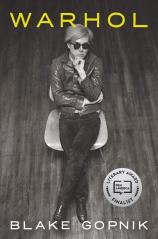Warhol
Review
Warhol
Art critic and biographer Blake Gopnik has constructed a portrait of the late Andy Warhol that has left no fact unturned. This lengthy, lively tale is designed to enchant both Warhol fans and those new to his unusual take on visual artistry and life in general.
Gopnik records that, as a child growing up poor in Pittsburgh, Andrew Warhola was given a screen projector by his mother and would happily play the same Mickey Mouse cartoons over and over. Later, in art school, Warhola excelled at a certain assignment that points to his future creative interests: he drew a highly accurate picture of a Coca-Cola bottle from memory.
"Blake Gopnik has constructed a portrait of the late Andy Warhol that has left no fact unturned. This lengthy, lively tale is designed to enchant both Warhol fans and those new to his unusual take on visual artistry and life in general."
By the 1950s, the pale, rather shy-looking man moved to New York and became Warhol, with certain trademark quirks: he sported a wig to cover his thinning pate and wore glittering gold shoes. Following success in the design industry, Warhol’s individual artworks began to attract attention, with graphic repetition being a hallmark. He immortalized, some would say, the humble Campbell Soup can, and gave us repeated reminders of such adored but tragic symbols as Marilyn Monroe and Elvis Presley.
By the time of his death in 1987, Warhol was known across the world as talented, eccentric, outrageous and outspoken --- yet somehow rather lovable. Movies like Sleep (five-plus hours focused on a man sleeping) cemented his reputation for the bizarre, even as he courted and won the favor of wealthy patrons, survived an assassination attempt, and would later be seen as a cultural icon. His huge canvas depicting “Silver Car Crash (Double Disaster)” in black and white panels sold posthumously for the highest price on record at the time, $105 million.
As Gopnik weaves this rich, highly detailed tapestry, he has included much matter regarding Warhol’s sexuality. In his early 20s in the late 1940s, Warhol might well have wished to come out of the darkened closet reserved for the sexually different in that era, but the legal penalty for homosexual activity in Pennsylvania could be as onerous as 10 years of hard labor. Gravitating to the liberal underground of New York City, he was able to express his desires more openly and did so, as Gopnik makes clear; by the time the ’60s rolled around, he led the way in free loving.
Indeed, whether it be Warhol’s sexual escapades or his charms with the society ladies, art collectors and a large admiring band of misfits and dreamers, there is very little in this extensive examination about which the author has not provided on-the-scene, almost minute-by-minute, quotations and recollections from Warhol’s observers, detractors and lovers. The artist’s devotees will enjoy the revelations Gopnik has teased out regarding a man who, like Picasso and Dalí before him, enjoyed shocking his public almost as much as he relished displaying and purveying his undeniable, genius-level graphic gifts.
Reviewed by Barbara Bamberger Scott on May 1, 2020
Warhol
- Publication Date: April 20, 2021
- Genres: Biography, Nonfiction
- Paperback: 976 pages
- Publisher: Ecco
- ISBN-10: 0062298429
- ISBN-13: 9780062298423



